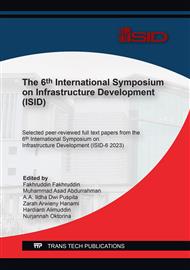[1]
G.H. Powell, Modeling for Structural Analysis Behavior and Basics, Computers and Structures, Berkeley, 2010.
Google Scholar
[2]
A. Wood, Pavements in the sky: the skybridge in tall buildings, Arq 7 (2003) 325–332.
DOI: 10.1017/S1359135503002264
Google Scholar
[3]
R. Doroudi, S.H. Hosseini Lavassani, Connection of coupled buildings: A state-of-the-art review, Structures 33 (2021) 1299–1326.
DOI: 10.1016/j.istruc.2021.05.017
Google Scholar
[4]
M. Krynski, D. Wittenberg, D. DeLong, Eaton's Center: Design of a Pedestrian Glass Sky Bridge, in: Structures Congress 2012, American Society of Civil Engineers, Chicago, 2012, p.438–447.
DOI: 10.1061/9780784412367.039
Google Scholar
[5]
S. Mahmoud, Horizontally connected high-rise buildings under earthquake loadings, Ain Shams Engineering Journal 10 (2019) 227–241.
DOI: 10.1016/j.asej.2018.12.007
Google Scholar
[6]
I.S. Abbood, M. Mahmod, A.N. Hanoon, M.S. Jaafar, M.H. Mussa, Seismic Response Analysis of Linked Twin Tall Buildings with Structural Coupling, International Journal of Civil Engineering and Technology (IJCIET) 9 (2018) 208–219.
Google Scholar
[7]
S.A. Hussain, M.A. Azeem, A. Minhajuddin, Effect on Seismic Behaviour of Structurally connected Tall Buildings, International Journal of Engineering Research and Applications 12 (2022) 143–151.
Google Scholar
[8]
Z. Jiang, A. Meier, J. Porretta, S. Belini, J. Caicedo, J. Wong, D. Shook, R. Henoch, J. Zhang, Improving Performance of Connected High-Rise Structures Through The Use of Skybridges, 17th World Conference on Earthquake Engineering (2020).
Google Scholar
[9]
J. Lim, B. Bienkiewicz, Effects of Structural and Aerodynamic Couplings on the Dynamic Response of Tall Twin Buildings with a Skybridge, in: Structures Congress 2009, American Society of Civil Engineers, Austin, Texas, United States, 2009, p.1–9.
DOI: 10.1061/41031(341)77
Google Scholar
[10]
J.A. Alomari, Conceptual Seismic Analysis of Two R.C. Adjacent Buildings with Different Dynamic Properties Connected Horizontally by Sky Bridges, Journal of Engineering Science and Technology 16 (2021) 2610–2628.
Google Scholar
[11]
Y. Zhou, X. Lu, W. Lu, J. Qian, Study on the seismic performance of a multi-tower connected structure, Struct. Design Tall Spec. Build. 20 (2011) 387–401.
DOI: 10.1002/tal.533
Google Scholar
[12]
J.K. Wight, Reinforced Concrete: Mechanics and Design, Seventh edition, Pearson, Hoboken, 2016.
Google Scholar
[13]
A.K. Chopra, Dynamics of Structures: Theory and Applications to Earthquake Engineering, Fifth edition, Pearson, Hoboken, 2017.
Google Scholar
[14]
F. Naeim, ed., The Seismic Design Handbook, Springer US, Boston, 2001.
DOI: 10.1007/978-1-4615-1693-4
Google Scholar
[15]
J. Hancock, J. Watson-Lamprey, N.A. Abrahamson, J.J. Bommer, A. Markatis, E. McCoy, R. Mendis, An Improved Method of Matching Response Spectra of Recorded Earthquake Ground Motion Using Wavelets, Journal of Earthquake Engineering 10 (2006) 67–89.
DOI: 10.1080/13632460609350629
Google Scholar
[16]
C. Tura, K. Orakçal, Earthquake Response Analysis of Multiple Towers on a Common Podium: A Representative Case Study, Teknik Dergi (2019).
DOI: 10.18400/tekderg.467371
Google Scholar
[17]
K.T. Tse, J. Song, Modal Properties of Twin Buildings with Structural Coupling at Various Locations, in: Proceedings of the Eighth Asia-Pacific Conference on Wind Engineering, Research Publishing Services, 2013, p.862–869.
DOI: 10.3850/978-981-07-8012-8_175
Google Scholar
[18]
J.S. Przemieniecki, Theory of Matrix Structural Analysis, McGraw-Hill, Inc., New York, 1968.
Google Scholar
[19]
I. Grytting, F. Svalestuen, J. Lohne, H. Sommerseth, S. Augdal, O. Lædre, Use of LoD Decision Plan in BIM-projects, Procedia Engineering 196 (2017) 407–414.
DOI: 10.1016/j.proeng.2017.07.217
Google Scholar
[20]
A.S. Hadi, A.M. Abd, M. Mahmood, Integrity of Revit with structural analysis softwares, IOP Conf. Ser.: Mater. Sci. Eng. 1076 (2021) 012119.
DOI: 10.1088/1757-899X/1076/1/012119
Google Scholar
[21]
A.Z. Sampaio, A.M. Gomes, BIM Interoperability Analyses in Structure Design, CivilEng 2 (2021) 174–192.
DOI: 10.3390/civileng2010010
Google Scholar
[22]
Z. Xu, X. Lu, X. Zeng, Y. Xu, Y. Li, Seismic loss assessment for buildings with various-LOD BIM data, Advanced Engineering Informatics 39 (2019) 112–126.
DOI: 10.1016/j.aei.2018.12.003
Google Scholar
[23]
S. Fai, J. Rafeiro, Establishing an Appropriate Level of Detail (LoD) for a Building Information Model (BIM) – West Block, Parliament Hill, Ottawa, Canada, ISPRS Ann. Photogramm. Remote Sens. Spatial Inf. Sci. II–5 (2014) 123–130.
DOI: 10.5194/isprsannals-II-5-123-2014
Google Scholar
[24]
J.P. Moehle, J.D. Hooper, T.R. Meyer, Seismic Design of Cast-In-Place Concrete Diaphragms, Chords, And Collectors: A Guide for Practicing Engineers, Second Edition, National Institute of Standards and Technology, Gaithersburg, 2016.
DOI: 10.6028/NIST.GCR.16-917-42
Google Scholar
[25]
T. Brown, A. Elshaer, Pounding of structures at proximity: A state-of-the-art review, Journal of Building Engineering 48 (2022) 103991.
DOI: 10.1016/j.jobe.2022.103991
Google Scholar
[26]
J.P. Moehle, J.D. Hooper, Seismic Design of Reinforced Concrete Special Moment Frames: A Guide for Practicing Engineers, Second Edition, National Institute of Standards and Technology, Gathersburg, 2016.
DOI: 10.6028/NIST.GCR.16-917-40
Google Scholar


